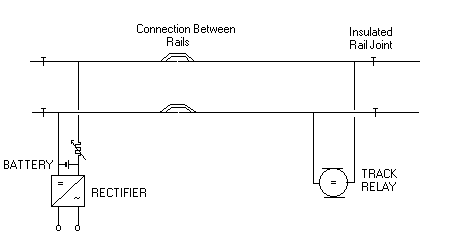|
Track circuit is one of the primary input for a signal interlocking
plant. Opps ! hold on. What is an 'interlocking plant'? It is
the control logic behind the signaling system. The signal cannot be
'green' while there is another train on track segment ahead. The system
should able to detect the condition of the track segment: occupied or not.
The tracks are segmented into 'blocks'. Each block is track
circuited separately. The figure below illustrates a track circuit.

The track circuit consists of a power supply
on one end and a directional (polarized) relay on the other end. The power
supply has a 6V battery kept charged by a 6V/6A rectifier. In case of
power failure the battery will supply power to the circuit. The
track relay (TR), which has a resistance of 30 ohm and a pickup voltage of 1.4
volt, is normally held in picked-up state the circuit being completed via the
rails. When a train enters the segment the axels of the train short
circuit the supply to the relay and the relay drops. The contacts of
the track relays appear in most of the safety circuits of the interlocking
plant. The interlocking logic is arranged such that only one train can be
permitted to enter a section. If you carefully observe, the track circuit
is fail safe; if the circuit fails it will indicate occupancy. The
variable resister is introduced into the circuit such that it can be tuned to
make the system works under all weather conditions. The rails are
insulated to separate the adjacent track circuits. The polarity of the
adjacent track circuit is always reversed, so that the power supply of one
circuit cannot operate the relay of the other circuit should the insulate
between the circuits breakdown. Within one track circuit the rails are
electrically connected by two wires (for safety). The minimum
length of track circuit is depends on the degree of control necessary and the
maximum length is limited by the weather conditions. On the Northern
line from Loco Junction (Maradana) to Veyangoda, the segments
have a maximum length of 2000 feet. On the Southern line from Loco
Junction to Wadduwa, due to the saline atmosphere along the cost line, the track
circuits are limited to 1500 feet max.
Now that we have looked upon the track relay we will get into discuss the
types of Relays used in the railway signaling. |